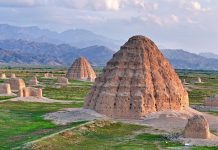XI’AN: Chinese researchers have found golden snub-nosed monkeys, the earth’s northernmost distributed leaf-eating primate, deliberately accumulate fat reserves during summer and autumn to combat resource scarcity in winter.
The relevant studies have been published in Ecography and Journal of Animal Ecology as their cover articles.
While over 94 percent of non-human primates dwell in tropical and subtropical areas, the leaf-feeding golden monkeys living in the Qinling Mountains suffer from severe cold and resource stress as leaves are scarce during the long winter.
“The monkeys can’t rely merely on buds and bark to meet their basic nutritional and energy needs in winter,” said Hou Rong, a researcher with the Shaanxi Key Laboratory for Animal Conservation.
As the golden monkeys need extra energy to regulate their body temperature in winter, their daily energy consumption can be greater than their intake, resulting in an energy deficit, Hou added.
Since 2011, researchers have been conducting studies in the Zhouzhi National Nature Reserve on the northern slope of the Qinling Mountains, sampling around 140 golden snub-nosed monkeys to track their dietary habits.
Through a decade of observation and research, it has been uncovered that the species’ major strategy to survive the harsh winter is ingesting excess fats and carbohydrates when sufficient food is still available.
In summer, the golden monkeys will eat a lot of fat-rich fruits apart from their staples, whereas oak acorns, a type of common starchy nut in the region, have become their favorite during autumn.
“Groups of golden monkeys are often seen digging up leaves and picking up acorns in autumn,” Hou said. “Since the acorns have a shell, they crack them open with their teeth like sunflower seeds.”
Acorns, pinenuts and other high-fat foods are also good choices. As pinenuts are not abundant in their habitat, it often leads to fights and conflict among the monkeys when the nuts mature.
According to the studies, the snub-nosed monkeys have the highest energy intake of the year during autumn. The animal can reach its maximum weight at the end of autumn while its weight begins to steadily decline in the winter until it is down to the lowest level at the beginning of the next spring.
Through quantitative studies of nutrients and energy, Hou’s team found that adult monkeys lost 14 percent of body mass over the winter, very likely from the loss of adipose tissues, and the loss closely matched the calculated winter energy deficit.
“It suggests that adipose tissues play a critical role in regulating the seasonal energy budget of our study population,” Hou explained.
The golden snub-nosed monkeys also make a series of behavioral changes to help compensate for winter energy deficit, including increasing feeding time, moving less and resting more than on warmer days.
Additionally, the reduced skin temperature, an average of 3.2 degrees Celcius, could also attribute to decreasing dry heat loss. – Agencies





